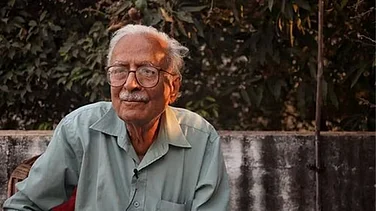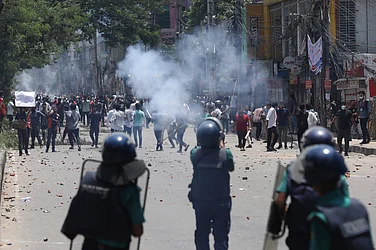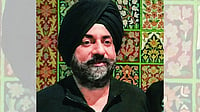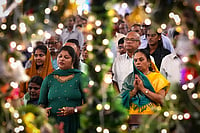For the past several years, Bansi Lal, 52, has been looking after Jammu city’s Mata Sharika temple — a replica of Jagdamba Sharika Bhagwati atop the Hari Parbat hillock next to Dal Lake in Srinagar city that is considered an abode of the goddess.
The temple was constructed by Kashmiri Pandits who made the city of temples their second home after being driven out of the Valley in early 1990, when a Pakistan-backed armed insurgency started sweeping the Valley.
Originally a resident of Kishtwar’s Chhatroo village in Jammu province, Bansi abandoned his home and mountain farms and fled to Jammu city in 2005. Those were the days when the region was infested with trigger-happy terrorists — both local and foreign — who were selectively killing members of his community, besides all those who were suspected to be collaborators. Massacres were the order of the day.

While his family has been provided accommodation on the temple premises, its management gives him a monthly honorarium of Rs 5,000. “During all these years, I have never received any help from the government that it gives to Kashmiri migrants,” Bansi tells Outlook, narrating how, despite financial constraints, he has ensured the higher education of his four children, including three daughters.
Now he is worried about their employment. But the story of his struggle is not different from thousands of faceless, internally-displaced militancy-affected migrants in Jammu province, who remain out of government and media’s sight.
They come from remote and almost inaccessible villages on the Pir Panjal range. In many cases, even news of massacres in their respective villages — as it happened in Reasi district’s Prankote area, where 28 people were hacked to death on the night of April 17, 1998 — would reach the authorities only after 24 hours.
Justice for Trial — an Ahmedabad-based NGO that comprised former governor of Himachal Pradesh V.S. Kokje and a former additional advocate general of the Rajasthan Government G.S. Gill — had highlighted their poor plight in the media in 2010. Their report recorded that Jammu migrants, scattered all over hilly areas, were compelled to put up in inhuman conditions.
For over seven years, these migrants staged a peaceful sit-in protest in front of the divisional commissioner’s office at Mubarak Mandi. Without any success, they had to call off their protest in 2011 after the office shifted to a new building at Rail Head Jammu.
Significantly, the Relief & Rehabilitation Commission (M) J&K has only 979 registered families of migrants from hilly regions of Doda, Ramban, Kishtwar, Reasi, Udhampur, Rajouri and Poonch districts, all under Jammu. These families got displaced between 1998 and 2004, according to the Commission’s website. “Majority are stationed at NHPC Colony Talwara in Reasi, or Panthal, Udhampur, and Ramban, with only a few relocated to Jammu district.”
NHPC Colony Talwara is located close to the right bank of the mighty Chenab that flows along the northern fringe of Reasi town. A cluster of dank, dark and cramped sheds, the colony is a home to 2,221 families of Hindus and Muslims who fled terrorist assault in different areas of Jammu region.
With tar-felt cement-sheet roofs covered with tattered tarpaulin, and, in some cases, tin sheets, these structures stand in shambles, resembling long abandoned and defaced pigeonholes. Earlier this camp used to house labourers who worked for the construction of Salal Hydroelectric Power Station on Chenab, way back in 1978.
On several occasions, the NHPC has tried to dismantle the colony after declaring it unsafe and unauthorised. While the migrants have got a stay order from court, camp residents lament they have been barred from the benefits of government welfare schemes.
Following a Supreme Court judgement in 2016, the J&K government registered 642 of the families and started providing them a monthly relief of Rs 13,000 and free food and ration, just like they do to Pandits from the Valley, according to Jagdev Singh, president of the Migrant Action Committee Talwara. “But the remaining 1,800 families have been left to fend for themselves,” says Singh.
Most of the campers — including those who are registered — do manual labour or menial jobs for sustenance. Speaking about the cramped conditions at the camp and the pestering problems posed by acute poverty, the campers keep harking back to the content life of their native villages where they had adequate agricultural land, livestock and abundant natural resources to live by happily.
But when the Talwara migrants talk about past incidents filled with vivid images of violence and loss of life and property, official apathy dominates their list of grievances. They blame the government for their present condition. The blood-stained memories still weigh like nightmares on their hearts and minds.
Octogenarian Krishna Devi and her family arrived at the camp from a remote mountain hamlet, Kot Charwal in Rajouri district, after terrorists burnt alive 15 Muslim shepherds inside three homes in February 2001. The charred bodies included seven children, the youngest just four years old.
“This carnage was a warning to the villagers who opposed them,” she recalls, saying some among those killed were armed members of the village defence group.

In the mid 1990s, the government had decided to supply weapons to people in militancy-infested areas and constituted village defence committees. Of late, some J&K BJP leaders have stressed on reviving these committees to strengthen the security grid.
While security forces claim a considerable decline in militancy, migrants refuse to return to their homes. The reasons go beyond security concerns. “We do not have money to rebuild houses, purchase livestock and make the long-abandoned land cultivable again,” says Jagdev Singh. “If we go back, we will have to start from scratch all over again.”
“Their reintegration with life back home remains a real challenge for the government,” says Nishikant Khajuria, a senior Jammu-based journalist. Stressing on a durable rehabilitation policy for the long suffering Jammu migrants, Nishikant adds, “Being educationally impoverished, they could never articulate their problems and highlight their issues the way Kashmiri Pandits do to catch national and international attention. Under the shadow of the Kashmir conflict, they have been completely ignored.”
Words of assurance by successive governments have proven inadequate in containing their sense of horror and loss. “Migrants of Jammu and of Kashmir are both victims of the same circumstances. And yet, the government has been discriminating against us, that too against Supreme Court directions,” says Jagdev Singh, decrying the strange dichotomy.
Recently, Bhim Singh, the president of Jammu and Kashmir National Panthers Party and senior Supreme Court lawyer, urged Lt. Governor Manoj Sinha that all Jammu migrants should be treated on a par with Kashmiri migrants, as per the apex court’s directions to the Union and UT governments.
In his written representation, Bhim, who had represented Jammu migrants in the apex court, also demanded construction of colonies for Jammu migrants, employment packages and clearance of arrears due from 1998 to 2021 on a par with Kashmiri migrants, besides registration of bifurcated and left-out families.
Belicharana, which sits on the left bank of river Tawi — a sluggish waterway that flows through Jammu city — used to have a cluster of makeshift homes of non-Kashmiri internally-displaced migrants. While many families have disappeared over the years, some have constructed their permanent homes at the site.

Pyara Singh, 67, who runs a small shop here, had also fled Kishtwar after terrorists gunned down 16 civilians in his village, Thakrai, and an adjoining village Sarwan on July 28, 1998.
Summing up the sentiments of many militancy-affected displaced persons in Jammu region, he comments, “Neither did I ask, nor did the government help me in any way.”


























